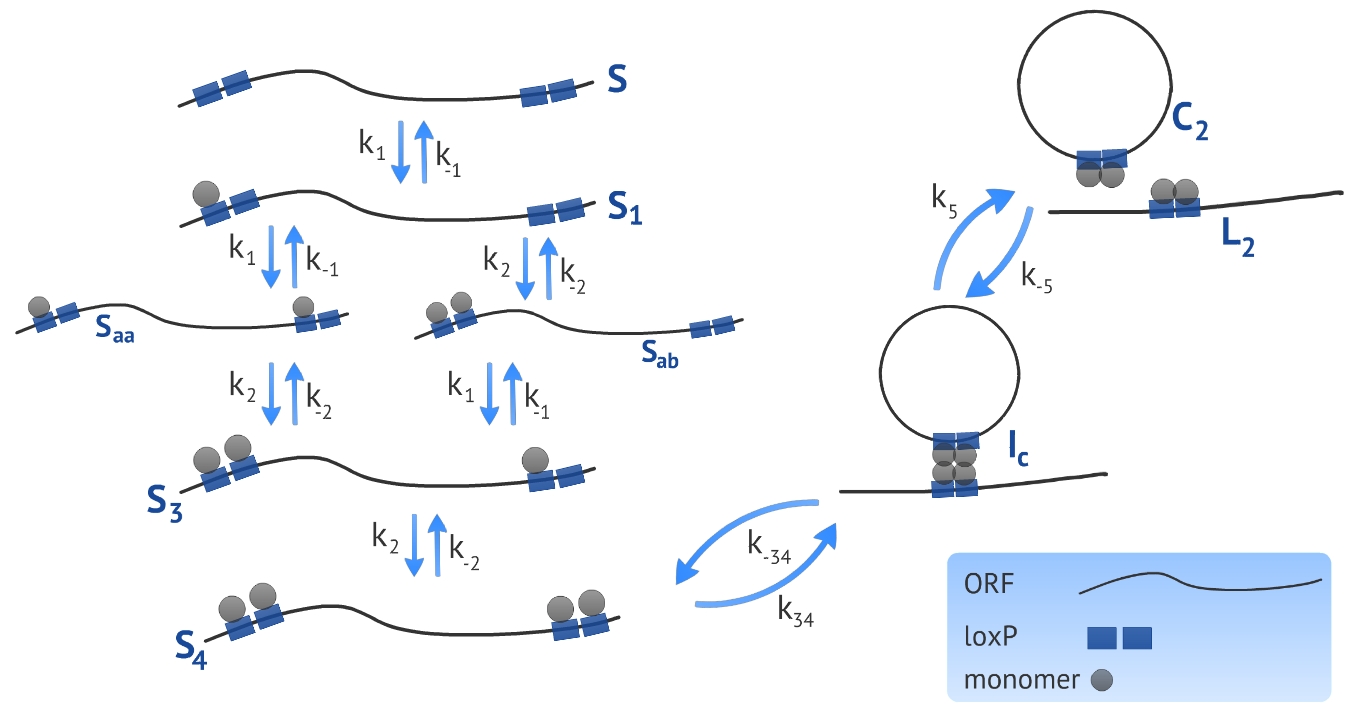Team:USP-UNESP-Brazil/Associative Memory/Modeling
From 2012.igem.org
 Introduction
Introduction Project Overview
Project Overview Plasmid Plug&Play
Plasmid Plug&Play Associative Memory
Associative MemoryNetwork
 Extras
ExtrasContents |
Associative Memory
Introduction
We introduced a mathematical model for two populations of bacteria that interact via quorum sensing. Each population produces its own quorum sensing molecule (QSM) and the QSM of one population can be repressive or excitatory to the other population in a mechanism analogous to a neuron communication. In our case, a neuron is represented by a population of bacteria and a synapse by a communication via QSM. In our analogy, a neuron is activated when the majority of the population is in quorum, which means producing the QSM with a high rate.
Mathematical Model
Ward et al [1], introduced a mathematical model to describe the growth of populations of bacteria consisting in cell that can be either up-regulated or down-regulated. An up-regulated cell produces QSM faster than a down-regulated cell which produces it in a basal rate. If the most bacteria in the population is up-regulated we say the population is in quorum. The model consists in three differential equations:
\begin{align} \frac{d}{dt} N_{d} &= rN_{t}\Big[1 - \frac{N_{t}}{K}\Big] - \alpha A N_{d} + \beta N_{u} \\ \frac{d}{dt} N_{u} &= \alpha A N_{d} - \beta N_{u} \\ \frac{d}{dt} A &= \kappa_{u} N_{u} + \kappa_{d} N_{d} - \alpha A N_{d} - \lambda A \\ N_{t} &= N_{d} + N_{u} \end{align}
where $N_d$ and $N_u$ are the down-regulated and up-regulated subpopulations density (number of cells per volume), $A$ is the density of QSM, $\kappa_{d}$ and $\kappa_{u}$ are the QSM prodution rate of down-regulated and up-regulated, respectively. The variable $\lambda$ is the degradation rate of the QSM and $r$ is the cell-division rate. It is assumed that down-regulated cells are up-regulated by QSMs with rate constant $\alpha$ and up-regulated becomes down-regulated with the rate $\beta$. The authors designed some experiments in order to estimate the constants, table 1. For example, the values for $K$ and $r$ were determined by examination of the growth curve.
In our model, there are two different types of population of bacteria and each type has his own QSM, represented by $A$ and $B$. In order to evaluate an interaction between the two type of bacteria we introduced a term in the model proposed by Ward et al *********ref***********. We assumed that type A up-regulated cells becomes down-regulated by B with the rate $\phi_B$ and vice-versa.
\begin{align}
\frac{d}{dt}N_{Ad} &= rN_{At}\Big[1 - \frac{N_{At}}{K}\Big] - \alpha_A A N_{Ad} + (\beta_A + \phi_B B)N_{Au} \\
\frac{d}{dt}N_{Bd} &= rN_{Bt}\Big[1 - \frac{N_{Bt}}{K}\Big] - \alpha_B A N_{Bd} + (\beta_B + \phi_A A)N_{Bu} \\
\frac{d}{dt}N_{Au} &= \alpha_A A N_{Ad} - \beta_A N_{Au} - \phi_B B N_{Au}\\
\frac{d}{dt}N_{Bu} &= \alpha_B B N_{Bd} - \beta_B N_{Bu} - \phi_A A N_{Bu} \\
\frac{d}{dt}A &= \kappa_{Au} N_{Au} + \kappa_{Ad} N_{Ad} - \alpha_A A N_{Ad} - \lambda_A A - \phi_A A N_{Bu} \\
\frac{d}{dt}B &= \kappa_{Bu} N_{Bu} + \kappa_{Bd} N_{Bd} - \alpha_B B N_{Bd} - \lambda_B B - \phi_B B N_{Au} \\
N_{At} &= N_{Ad}+N_{Au} \\
N_{Bt} &= N_{Bd}+N_{Bu}
\end{align}
Results
We first evaluated the fraction of cells up-regulated as a function of carrying capacity and of the ratio $\frac{\phi_A}{\phi_B}$,
The carrying capacity is an important parameter of the model. For values up to $10^8$, in the equilibrium, no population can reach quorum since the density of cells is too low, figure *****xis*****. On the other hand, for values higher than $10^8$ the population that has a higher repressive rate, represented by $\phi$, reachs quorum and represses the other population.
Equilibrium points
At the equilibrium point we have:
\begin{align} &-\alpha_A A N_{Ad} + \beta_A N_{Au} + \phi_B B N_{Au} = 0 \\ &\kappa_{Au} N_{Au} + \kappa_{Ad} N_{Ad} - \alpha_A A N_{Ad} - \lambda_A A - \phi_A A N_{Bu} = 0 \\ &-\alpha_B B N_{Bd} + \beta_B N_{Bu} + \phi_A A N_{Bu} = 0 \\ &\kappa_{Bu} N_{Bu} + \kappa_{Bd} N_{Bd} - \alpha_B B N_{Bd} - \lambda_B B - \phi_B B N_{Au} = 0 \\ &N_{Au} + N_{Ad} = K \\ &N_{Bu} + N_{Bd} = K \end{align}
[1] J. P. Ward, J.R. King, A. J. Koerber, P. Williams, J. M. Croft and R. E. Sockett Mathematical modelling of quorum sensing in bacteria. Math Med Biol (2001) 18(3)
[2] http://partsregistry.org/
 "
"


















